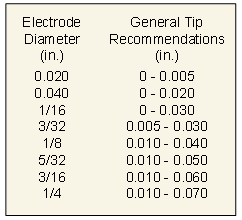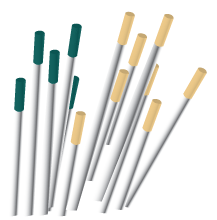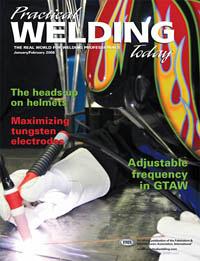- FMA
- The Fabricator
- FABTECH
- Canadian Metalworking
Categories
- Additive Manufacturing
- Aluminum Welding
- Arc Welding
- Assembly and Joining
- Automation and Robotics
- Bending and Forming
- Consumables
- Cutting and Weld Prep
- Electric Vehicles
- En Español
- Finishing
- Hydroforming
- Laser Cutting
- Laser Welding
- Machining
- Manufacturing Software
- Materials Handling
- Metals/Materials
- Oxyfuel Cutting
- Plasma Cutting
- Power Tools
- Punching and Other Holemaking
- Roll Forming
- Safety
- Sawing
- Shearing
- Shop Management
- Testing and Measuring
- Tube and Pipe Fabrication
- Tube and Pipe Production
- Waterjet Cutting
Industry Directory
Webcasts
Podcasts
FAB 40
Advertise
Subscribe
Account Login
Search
Selecting and preparing tungsten electrodes
How three critical electrode issues affect arc welding
- By Jon Bowers
- January 15, 2008
- Article
- Consumables
A favorite tungsten electrode analogy is that you may have the best welding equipment in the world, but without properly prepared tungsten electrodes to transfer the arc, your welding application is like driving a Porsche on its rims.
The tungsten electrode is one of the most important, and yet one of the most frequently overlooked, process variables in DC arc welding. Selecting and preparing them for welding involves three critical areas:
- Electrode geometry
- Electrode preparation
- Electrode preparation equipment
Electrode Geometry
The complete electrode geometry for DC welding comprises the electrode diameter, the included angle (taper), and the tip (flat) (see Figure 1).
The choice of geometry will always affect electrode life, arc starting, weld penetration, and arc shape. Regardless of the geometry selected, the electrode configuration must be tested during welding procedure development. The geometry should be noted as a critical process variable for the weld procedure and held to close tolerances for all subsequent welds.
Electrode Diameter. The best place to start when choosing the electrode diameter is to consult the welding equipment manufacturer's recommendations. While small diameters are easier to arc-start, large diameters accommodate higher amperages and last longer than smaller diameters. However, ifcurrent levels are higher than recommended, the tungsten will deteriorate too rapidly, fall into the weld pool, and contaminate the weld. Conversely, if the current is too low for the electrode diameter, the arc will become unstable.
Electrode Included Angle (Taper). Electrodes for DC welding should be ground longitudinally and concentrically with diamond wheels to an included angle in conjunction with the tip/flat preparation.
A blunt taper with a large included angle results in longer electrode life, better weld penetration, narrower arc shape, and the ability to handle more amperage without eroding. A sharp taper with a small included angle offers less arc wander and a wider, more consistent arc.
Tip (Flat). The shape of the tungsten electrode tip is an important process variable in precision arc welding, because as the flat size increases, so does the chance of arc wander and starting difficulty. However, increasing the flat also improves weld penetration and increases electrode life (seeFigure 2).
An incorrect, inconsistent flat can cause pointed electrode tips to drop into the weld pool. It also can result in arc instability, reduced electrode life, and changes in arc voltage from one electrode to another.
Electrode Preparation
The tungsten electrode is the crucial carrier in the welding process and must be ground and cut properly. An improperly prepared electrode leads to arc wander, splitting, shedding, inconsistencies, or expensive mistakes. Properly ground and cut electrodes improve arc starting and stability.

Figure 1Electrode geometry comprises three factors: electrode diameter, the included angle (taper), and the tip (flat).
Diamond wheels are recommended for all tungsten electrode grinding and cutting. While tungsten is a very hard material, the surface of a diamond wheel is harder, which makes for a smooth grind. Grinding with other types of wheels can create jagged edges, imperfections, or invisible poor surface finishes that contribute to weld inconsistency and defects.
Tip (Flat) Preparation. Depending on the welding process, flat preparation might be on a new electrode or a previously used electrode. If the end of a used electrode is very contaminated, it should be removed before flat preparation. To recondition an electrode that has minimal contamination, either new or cut off, place the electrode at an exact 90-degree angle to the side of the wheel.
Taper Grinding. The most important element of proper electrode grinding is that the electrode be ground longitudinally. Tungsten electrodes are manufactured with the molecular structure of the grain running lengthwise, so grinding crosswise is grinding against the grain (see Figure 3).
More important, electrons flow at a greater density on the surface of the electrode. If electrodes are ground or polished crosswise, the electrons have to jump across the grinding marks. The arc begins before the tip, spreads out, and usually wanders. The tungsten electrode becomes overheated and wears out more quickly. With longitudinal grinding with the grain, the electrons are led steadily to the extreme tip of the tungsten electrode. The arc starts straight and remains narrow, concentrated, and stable.
A diamond grinding wheel should not be used for grinding anything other than tungsten. This will help ensure the wheel and tungsten tip do not become contaminated during the grinding operation and transfer foreign material to the weld.
Cutting to Length. A contaminated electrode produces an erratic arc and a contaminated weld. The best way to ensure that all contamination is removed from the tip is to cut off that part of tungsten. Grinding the tip when it's contaminated may not remove all of the contamination and will deposit the contamination on the grinding wheel, only to be picked up again in future grinding.
Because tungsten is a very hard material, proper cutting involves using a diamond cutting wheel for consistent, clean cuts. Many welders cut their tungsten incorrectly using one of the following methods:
- Breaking the electrode manually or with wire cutters
- Twisting the electrode with two pairs of pliers
- Notching the electrode on the grinding wheel and then breaking it by hand, with a hammer, or with pliers
- Hitting the electrode with a hammer on a sharp metal edge
All of these methods can cause safety and weld problems. The electrode can splinter or shatter unnoticeably, which can cause arc instability and weld defects, as well as the risk of eye or hand injury. It is much easier to cut an electrode quickly and properly with the correct cutting tool designed specifically for how hard and brittle tungsten is.
Using a diamond cutting wheel helps ensure that the cut is clean and smooth and void of fractures or splintering. The tool should be quick and easy to use, have safety covers, and provide a scale to ensure the exact length is measured and cut.
Electrode Angle Surface Finish. The smoothness of the finish on the prepared tip of the electrode determines some of the characteristics of the welding process. In general, points should be ground as fine as possible to improve welding properties and increase the service life of the electrode. Electrodes that are ground too coarse result in unstable arcs.

Figure 2The correct tungsten shape will prevent arc wander and starting difficulties. The table shows the suggested tip sizes based on the electrode diameter.
A standard finish of about 20 roughness average (RA), which would still show the longitudinally ground lines to the naked eye, is an all-purpose, quality finish for any application. A high-polished, mirror like finish of about 6 to 8 RA, in which few or no lines can be seen, is better for the longevity of the electrode, because it reduces the risk of contamination "sticking" to the electrode point and causing erosion. However, for welding power supplies that do not have strong arc-starting characteristics, a finish of about 20 RA is better because longitudinally ground lines help steadily lead electrons to the extreme point of the electrode, which assists in arc starting.
Electrode Preparation Equipment
In most applications, it is very important to have a dedicated tungsten electrode grinder. Standard grinding equipment at most facilities does not offer the means for proper longitudinal diamond grinding or consistency of preparation from one electrode to the next. In addition, a nondedicated machine contaminates the electrode with foreign material, which compromises weld quality in a number of ways.
For efficient production of consistent and repeatable electrodes and welds, consider the following characteristics in a grinder:
- Longitudinal grinding
- A diamond grinding wheel
- A cutting tool with a measurement apparatus that can cut short enough for the application, especially in the case of orbital welding
- 20 RA finish or better
- Precise grinding of tungsten in less than one minute
- Ability to meet required tolerances for the angle, length, and flat
- Simple, consistent operation that can be modified easily when different geometries are required
- Dust collection, especially for radioactive 2 percent thoriated tungsten electrodes
About the Author
Jon Bowers
2550 Azurite Circle
Newbury Park, CA 91320
805-498-3837
About the Publication
subscribe now

The Welder, formerly known as Practical Welding Today, is a showcase of the real people who make the products we use and work with every day. This magazine has served the welding community in North America well for more than 20 years.
start your free subscription- Stay connected from anywhere

Easily access valuable industry resources now with full access to the digital edition of The Fabricator.

Easily access valuable industry resources now with full access to the digital edition of The Welder.

Easily access valuable industry resources now with full access to the digital edition of The Tube and Pipe Journal.
- Podcasting
- Podcast:
- The Fabricator Podcast
- Published:
- 04/16/2024
- Running Time:
- 63:29
In this episode of The Fabricator Podcast, Caleb Chamberlain, co-founder and CEO of OSH Cut, discusses his company’s...
- Trending Articles
Sheffield Forgemasters makes global leap in welding technology

Welding student from Utah to represent the U.S. at WorldSkills 2024

Lincoln Electric announces executive appointments

Engine-driven welding machines include integrated air compressors

ESAB unveils Texas facility renovation

- Industry Events
16th Annual Safety Conference
- April 30 - May 1, 2024
- Elgin,
Pipe and Tube Conference
- May 21 - 22, 2024
- Omaha, NE
World-Class Roll Forming Workshop
- June 5 - 6, 2024
- Louisville, KY
Advanced Laser Application Workshop
- June 25 - 27, 2024
- Novi, MI




























